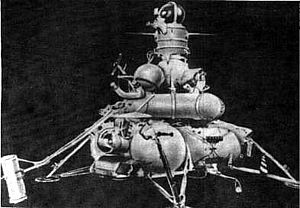Luna 15
 |
|
| Operator | Soviet Union |
|---|---|
| Major contractors | GSMZ Lavochkin |
| Mission type | Planetary science, lunar sample return |
| Launch date | 13 July 1969 02:54:42 UTC |
| Carrier rocket | Proton 8K82K + Blok D |
| Launch site | Baikonur Cosmodrome |
| Mission duration | 8 days |
| Mission highlight | Lunar impact |
| COSPAR ID | 1969-058A |
| Mass | 5,600 kg (12,000 lb) |
| Moon landing | |
| Date | 21 July 1969 15:47 UTC |
| Coordinates | 17°N 60°E / 17°N 60°E |
| Instruments | |
| Stereo imaging system Remote arm for sample collection Radiation detector |
|
| References: NASA NSSDC Master Catalog | |
Luna 15 (Ye-8-5 series) was an unmanned space mission of the Soviet Luna program, also called Lunik 15.
On July 21, 1969, while Apollo 11 astronauts finished the first human moonwalk, Luna 15 - an unmanned Soviet spacecraft in lunar orbit at the time, began its descent to the lunar surface. Launched only three days before the Apollo 11 mission, it was the third Soviet attempt to return lunar soil back to Earth. The Russian craft crashed on the moon at 15:50 UT – just a few hours before the scheduled American lift off.[1]
Contents |
[edit] Mission
Luna 15 was capable of studying circumlunar space, the lunar gravitational field, and the chemical composition of lunar rocks. It was also capable of providing lunar surface photography. Luna 15 was placed in an intermediate Earth orbit after launch and was then sent toward the Moon. After a mid-course correction the day after launch, Luna 15 entered lunar orbit at 10:00 UT on 17 July 1969. The spacecraft remained in lunar orbit for two days while controllers checked all on-board systems and performed two orbital maneuvers. After completing 86 communications sessions and 52 orbits of the Moon at various inclinations and altitudes it began its descent. Astronauts Armstrong and Aldrin had already set foot on the Moon when Luna 15 fired its main retrorocket engine to initiate descent to the surface at 15:47 UT on 21 July 1969. Unfortunately, transmissions ceased only 4 minutes after de-orbit at a calculated altitude of 3 kilometers. The spacecraft impacted the lunar surface on July 21, 1969. The spacecraft had probably crashed into the side of a mountain. Impact coordinates were 17° north latitude and 60° east longitude in Mare Crisium. A recording of the dramatic moment in which British technicians at the radio telescope facility in Jodrell Bank observed Luna 15's lunar descent was made available to the public for the first time on 3 July 2009.[2]
[edit] Implications
In a race to reach the Moon and return to Earth, the parallel missions of Luna 15 and Apollo 11 were, in many ways, the culmination of the space race between the space programs of both the United States and the Soviet Union in the 1960s. The simultaneous missions became one of the first instances of Soviet/American space cooperation as the USSR released Luna 15's flight plan to ensure it would not collide with Apollo 11, though its exact mission was unknown.[2]
[edit] References
- ^ "Russian spacecraft landed on moon hours before Americans". telegraph.co.uk. 4 July 2009. http://www.telegraph.co.uk/science/space/5737854/Russian-spacecraft-landed-on-moon-hours-before-Americans.html. Retrieved 2009-11-15.
- ^ a b Recording tracks Russia's Moon gatecrash attempt
| Preceded by Luna 1969C |
Luna programme | Succeeded by Cosmos 300 |
[edit] External links
|
|||||||||||
